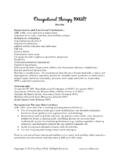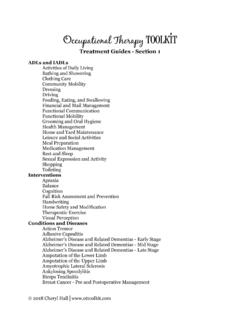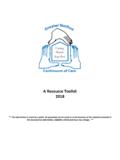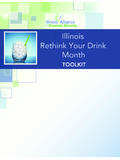Transcription of Occupational Therapy Toolkit
1 Copyright 2013 by Cheryl Hall. All Right Reserved Occupational Therapy Toolkit energy Conservation with Self Care Activities Remember to use your pursed lip breathing. Pace yourself and rest frequently. Eating 1. Eat slowly and completely chew your food. 2. Eat six small meals a day instead of three big meals. This will cut down on the energy you need to chew and digest your food. 3. Avoid gas-forming foods that bloat your abdomen and make it more difficult to breathe, such as peas, melons, turnips, onions, cauliflower, apples, corn, broccoli, cucumbers, cabbage, beans, and Brussels sprouts. Grooming 1. Sit to shave, comb your hair and brush your teeth.
2 2. Support your elbows on the counter while grooming or shaving. 3. Use an electric toothbrush and an electric razor. 4. Wash your hair in the shower. Keep your elbows low and your chin tucked. 5. Avoid aerosols and strong scents. Bathing and Showering 1. If your doctor has prescribed oxygen to be use during exercise, then use it when you take a shower. 2. Make certain your bathroom is well-ventilated. 3. Consider taking your shower in the evening to allow plenty of time. 4. Gather all the necessary items you will need, including your clothes. 5. Sit to undress, bathe, dry and dress. Use a bath chair in your shower. 6. Avoid over reaching. Use a long-handled brush to wash your back and feet.
3 Use a hand-held showerhead to rinse. 7. Use a shower caddy and soap on a rope or place soap in a nylon stocking and tie the stocking to the shower seat or soap dish. 8. Have a towel or robe near by. Consider using hand towels because they are not as heavy. Avoid the task of drying by putting on a terry cloth robe. Dressing 1. Gather all the necessary items you will need. 2. Sit to dress. 3. Minimize bending by bringing your foot to the opposite knee, use a step stool or use long-handled equipment to put on pants, shoes and socks. 4. Wear easy-to-put-on, comfortable clothes such as slip-on shoes; elastic waistbands and one sized larger shirts 5. Avoid restrictive clothes such as belts, ties, tight socks, girdles and bras.
4 Use suspenders if belts are too restricting.








